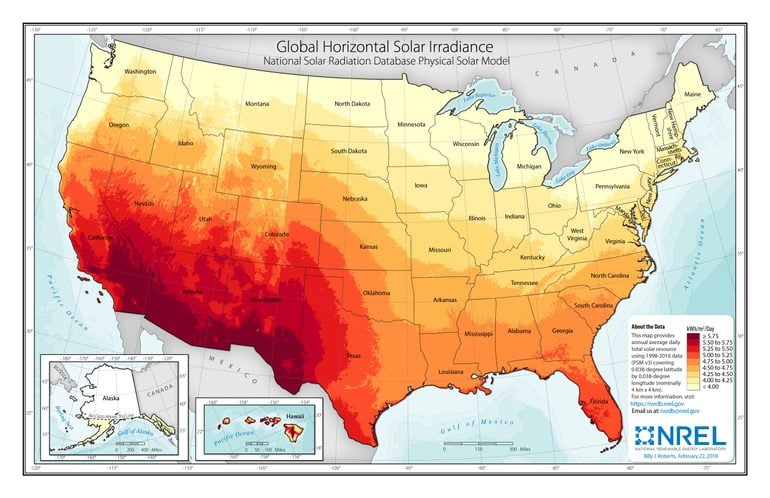A typical residence wants about 17 to 30 photo voltaic panels, in accordance EnergySage, a photo voltaic and residential power product comparability market
. This wide selection displays the various variables concerned, corresponding to power use and quantity of sunshine. For a median system measurement of 8.1kW in sunny California, you’ll want about 20 panels.
How you can calculate what number of photo voltaic panels you want for your home
To calculate what number of panels you want, you should use this components:
Variety of panels = annual electrical energy use ÷ photo voltaic panel manufacturing ratio ÷ photo voltaic panel output
The next steps information you thru the components.
1. Discover your own home’s annual electrical energy utilization
Your electrical energy use is measured in kilowatt-hours (kWh). To find out how a lot electrical energy your own home makes use of, have a look at your electrical invoice historical past, normally out there on-line at your utility’s web site. In case your fuel invoice is mixed along with your electrical invoice, have a look at the portion of your invoice that’s for electrical energy. You’ll want so as to add up 12 months of electrical invoice knowledge; in case your utility is one in all a rising quantity that gives Inexperienced Button knowledge from the U.S. Division of Vitality, you should use that to obtain a spreadsheet of your invoice historical past and rapidly calculate the overall kWh for a 12 months
.
2. Discover the manufacturing ratio on your location
Photo voltaic manufacturing ratio is the ratio of a photo voltaic panel’s estimated power output over time to its measurement. The manufacturing ratio will depend on your location, as a result of some areas get extra solar per day than others, rising a photo voltaic panel’s power output
. You possibly can lookup your state’s photo voltaic manufacturing ratio on this map created by EnergySage.
3. Decide the output of your photo voltaic panels
Your photo voltaic panel output is measured in watts. After you have quotes from installers, they may specify the output of the proposed panels. To calculate what number of panels you’ll want earlier than you get quotes, you should use 400W, the standard output for at the moment’s residential photo voltaic panels.
4. Calculate what number of panels you want
Let’s say your own home makes use of 10,791 kWh yearly, the common within the U.S. In case your manufacturing ratio is 1.5, like it’s for my residence in California, you’ll want 18 panels to cowl your whole residence’s power utilization:
10,791 ÷ 1.5 ÷ 400 = 17.99 panels
Utilizing this components offers you a tough, high-level estimate. Your photo voltaic installer can refine your system sizing, making an allowance for the components detailed beneath.
Components that have an effect on what number of photo voltaic panels you want
The precise variety of photo voltaic panels you’ll want will depend on these components:
Your present electrical energy use
The important thing think about figuring out the variety of panels you want is how a lot electrical energy you utilize. You probably have sufficient area in your roof, you’ll doubtless need sufficient photo voltaic panels to cowl your whole electrical energy use.
Your future electrical energy use
Do you anticipate your loved ones to develop? Are you planning to modify to an electrical automotive or a warmth pump? Will you be including a fridge, pool, or air con? It’s less expensive to put in sufficient photo voltaic now to cowl anticipated future use; that may additionally defend your funding if photo voltaic packages in your space, corresponding to internet metering, are phased out later.
The quantity of solar you get
The extra solar you get, the extra electrical energy your photo voltaic panels can generate and the less panels you’ll must cowl your electrical energy use. You may get an concept of the photo voltaic useful resource in your space from the Nationwide Renewable Vitality Laboratory (NREL) photo voltaic irradiance map.

Courtesy Nationwide Renewable Vitality Laboratory.
Panel wattage and effectivity
Right this moment’s typical residential photo voltaic installations use 400W panels, with a median vary from 350W to 450W. Panels at the moment have an common effectivity of 21% (with some as much as 23% environment friendly), which means that they convert 21% to 23% of the daylight that hits them into electrical energy
. Larger-watt and higher-efficiency panels produce extra power however are likely to price greater than their lower-watt and lower-efficiency counterparts. In case your roof area is proscribed, you could be restricted in what number of panels you’ll be able to have put in. In that case, you could need to think about higher-efficiency, higher-watt panels.
Your roof
What number of panels you’ll be able to have put in relies upon partially on the dimensions of your roof, however there’s extra to it than that. You’ll additionally want to think about the form of the roof, whether or not it has obstructions corresponding to vents and skylights, and whether or not it’s topic to shading from timber or buildings.
Your roof’s orientation additionally impacts the variety of panels you want; panels will generate probably the most power on a south-facing roof, adopted by east- and west-facing roofs
. In fact, your roof have to be in good situation to have the ability to help the load of the panels. After offering an preliminary quote utilizing on-line instruments, your installer will conduct a website go to to evaluate the situation of your roof and decide what number of panels you’ll be able to match on it. Should you can’t match sufficient panels in your roof to cowl all of your electrical energy wants, it might nonetheless be price protecting a portion of your electrical energy.
Does my home measurement have an effect on what number of panels I want?
Though home measurement could also be a think about what number of panels you want, a way more vital issue is your electrical energy use. You might be doubtless to make use of extra electrical energy when you’ve got a much bigger home, however that may not be the case if your loved ones is small and your home is energy-efficient.
Can I set up extra photo voltaic panels than I presently want?
Should you anticipate your electrical energy use to extend, it’s a good suggestion to measurement your system for these future wants. Some utility corporations have restrictions on system sizes, so verify along with your native utility to see how massive they may allow you to measurement your system.




